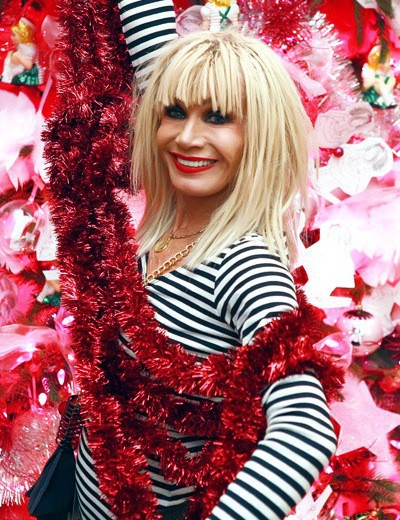
Betsey Johnson
About
Betsey Johnson was born in Connecticut, USA in 1942. Betsey Johnson is a fashion designer best known for her feminine and whimsical designs. She also is known for doing a cartwheel at the end of her fashion shows. She took many dance classes as a child and adolescent which inspired her love of costumes. After high school, Johnson spent a year at the Pratt Institute in Brooklyn, New York, before graduating from Syracuse University in 1964, where she was a member of the Alpha Xi Delta sorority.
During 1964, she was guest editor on the summer college issue of Mademoiselle and was hired by the magazine for one year after graduation. During that period she made and sold clothing designs in her spare time and later became a freelance designer, retailing through a New York boutique called Paraphernalia.
In 1967 she married Velvet Underground's John Cale. They divorced later in the year. She had a daughter, Lulu, in 1975 who now works with her.
The Look
For the youthquake generation, the names Betsey Johnson and Paraphernalia symbolized the hip, young fashions of mid-1960s America just as Mary Quant and Biba did for the equivalent age group in Great Britain. In the early 1970s, a second wave of young women with a taste for affordable style discovered the flippant body-conscious clothes Johnson designed for the ready-to-wear firm Alley Cat. Throughout the 1980s and into the 1990s, Johnson's clothes have been characterized by her sense of humor and an innocent, tongue-in-cheek sexiness. Wearing a Betsey Johnson dress is like putting on a good mood. Johnson's approach to clothing is very much influenced by her early days as a dancer. "I am basically about a ballerina torso and a full skirt," she told a reporter for the Soho News in 1982, "a dancing school dress-up craziness." Johnson's emphasis on tight, stretch bodices also grew out of her dancing school background. Not surprisingly, the shift in the 1970s to a subdued, tailored look was incompatible with Johnson's style as a designer. She continued to have her own label with a variety of manufacturers, but it was not until the end of that decade that Johnson's real joie de vivre emerged again, this time for her own company. Johnson's company and her girlish, bohemian style have continued to endure, despite the economic downturns of the late 1980s and the androgynous "grunge" trends of the early 1990s. In the final years of the century, Johnson's flirty and whimsical designs were again at the forefront of fashion trends. The youthful spirit of the company is kept alive through Johnson's own playful personality and the design talents of a young staff, including her daughter, Lulu Johnson. Betsey Johnson is the first to admit that her designs have changed little conceptually over her long career, but she is able to manipulate this basic style to suit a contemporary mood. Johnson's loyalty to her own vision has been crucial to her success and appeal.
Who Wears It
Rockers Now and Rockers Then: Madonna, Courtney Love, Cher, Lil’ Kim, Aerosmith’s Steven Tyler, Lenny Kravitz, Prince, Sarah McLachlan, Minnie Driver, Paris Hilton, Salma Hayek, Heather Graham, Helena Bonham Carter, Julie Christie, Brigitte Bardot, model Twiggy, Jackie Kennedy,